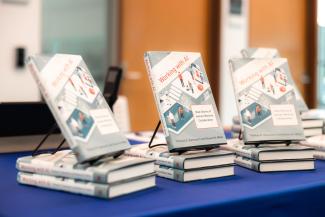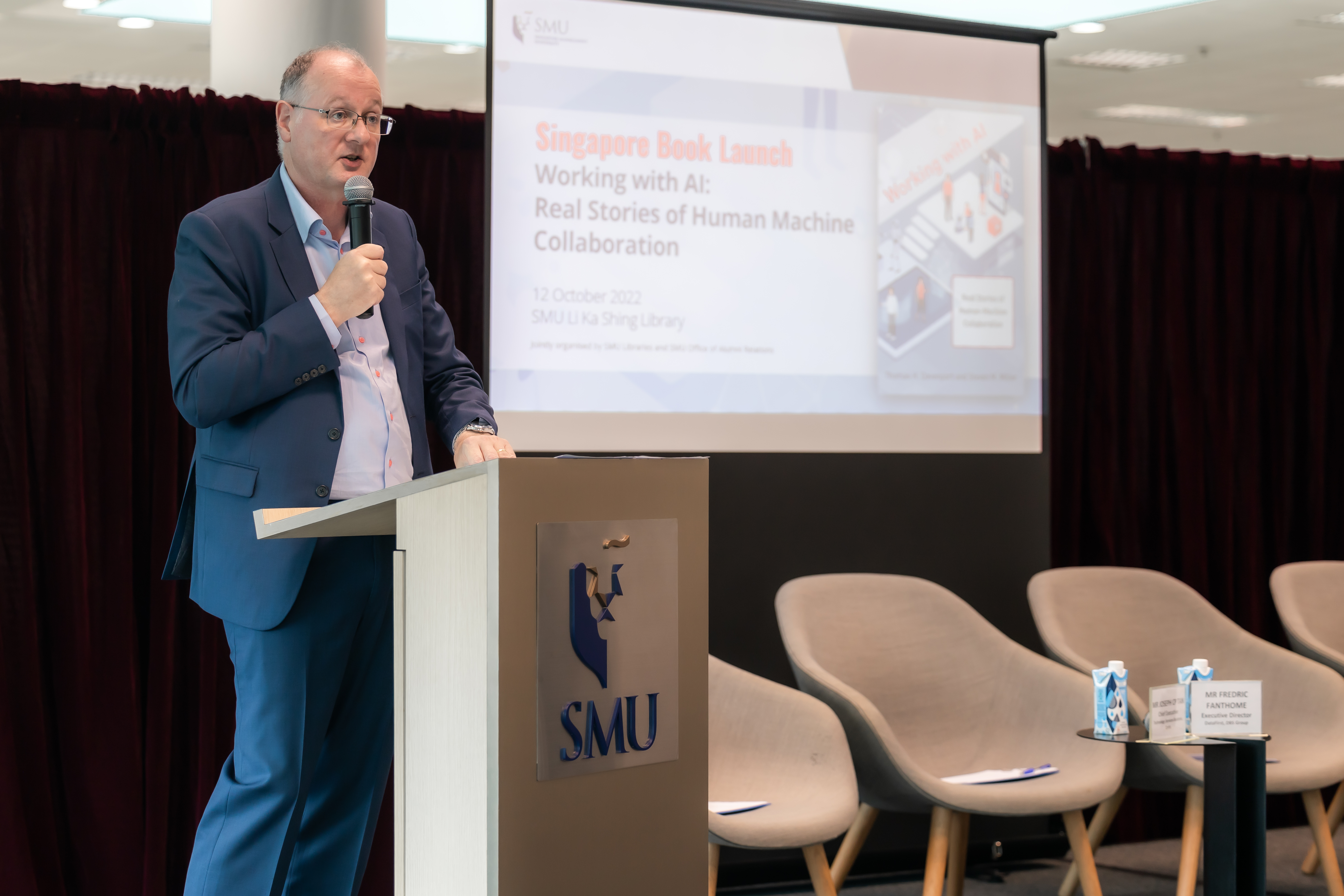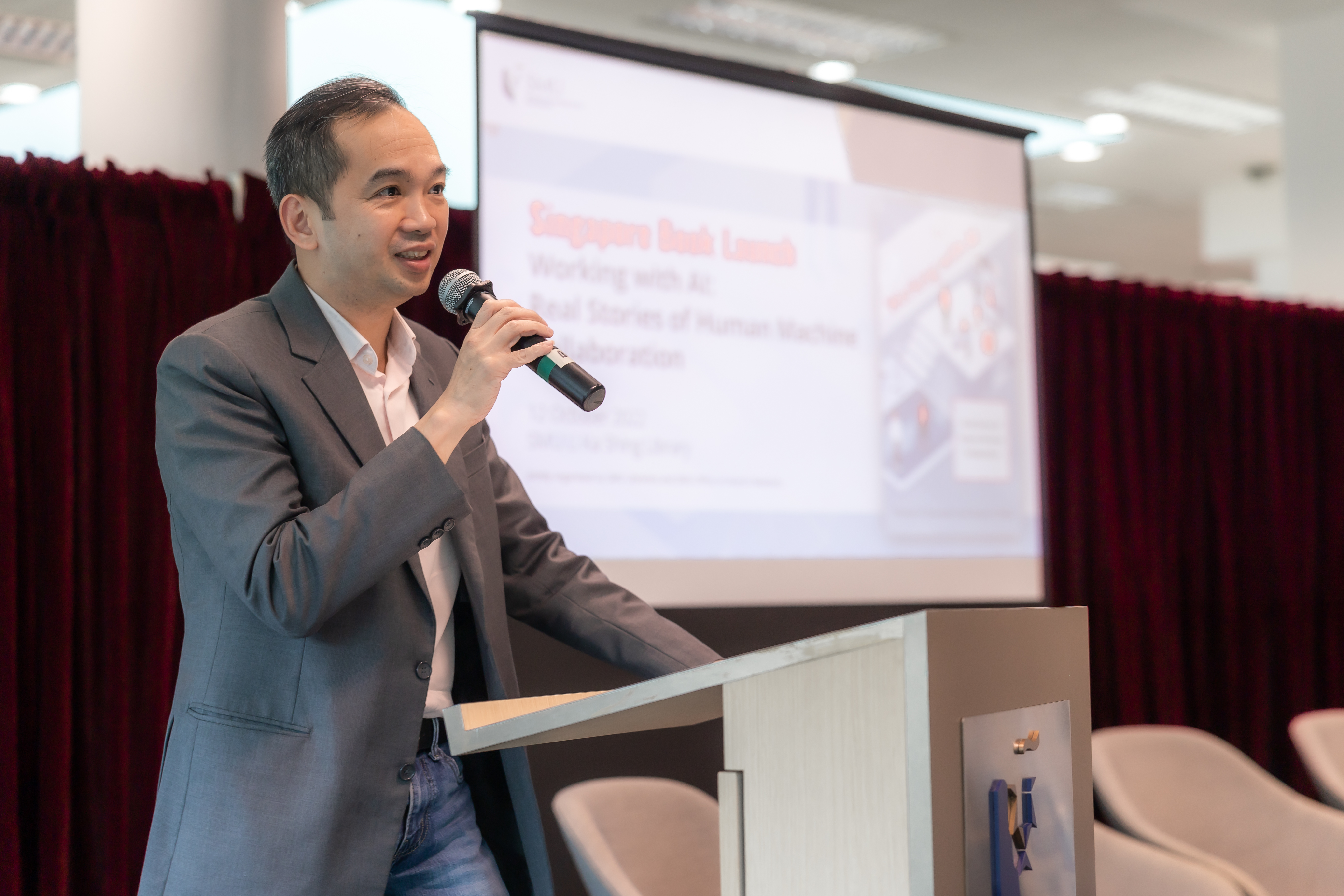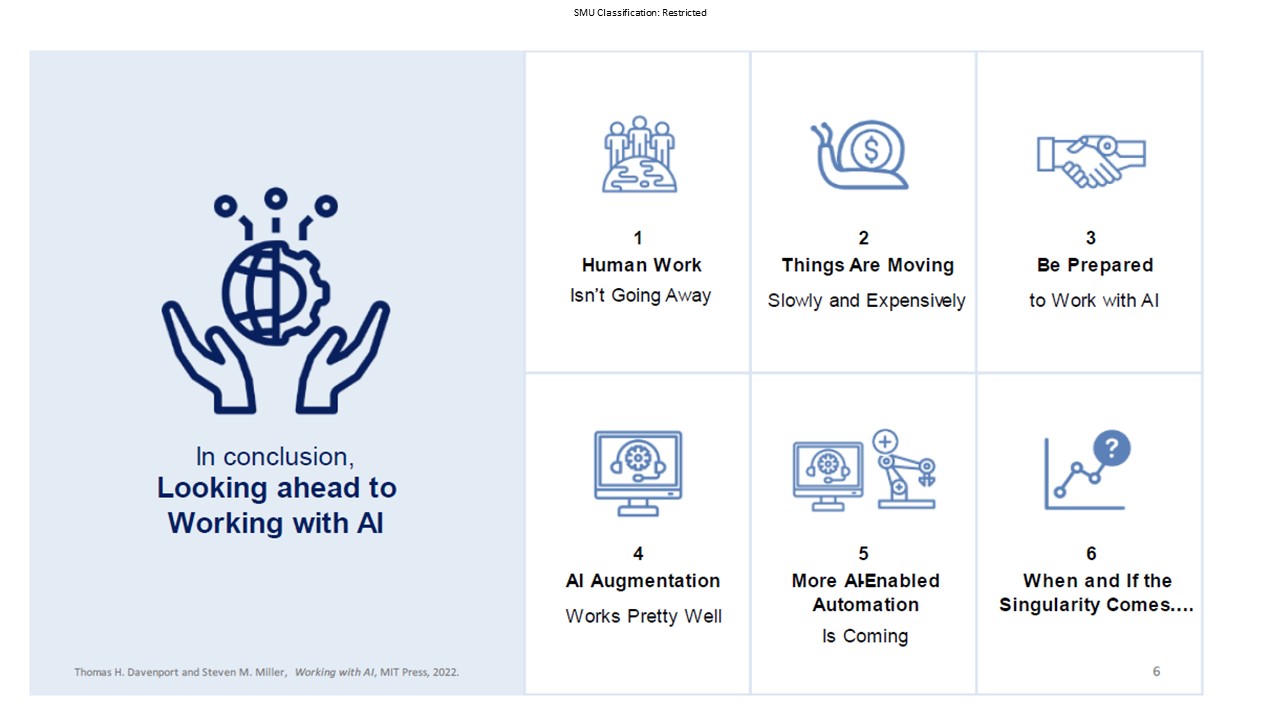
On 12 October, the Singapore Management University (SMU) hosted the book launch of “Working with AI: Real Stories of Human-Machine Collaboration” co-authored by Tom Davenport and Steve Miller.
Published by MIT press, the book contains 29 real-world case studies of people doing their everyday work with AI-enabled systems and automation, as well as seven chapters synthesising insights and exploring implications drawn from the case studies. The book provides a rich description of how companies are actually combining the capabilities of AI-enabled software systems and machines with human capabilities. Each case study example provides a distinctive portrait of what happens when an employee transitions to doing their everyday work with the assistance of an AI-enabled “smart machine”. The book also sheds light on supporting organisational efforts and roles involved in making this happen, and addresses some of the important implications as a result of this happening across more and more organisations.
In his remarks to open the event, Professor Timothy Clark, SMU Provost, drew upon his own research to comment on how humans are somehow able to interpret and ascribe meaning to the combination of both the non-verbal as well as verbal aspects of communication in highly context specific settings and detect very subtle nuances and implied meanings. He used this as an example of an “understanding” capability that even state-of-the-art AI systems are not very good at, and as a reason for why it is commonly the case that AI systems need to work together with people. This supports the key argument made by Davenport and Miller that most current AI applications work best as augmentation – machines used to compliment and amplify the capabilities of a person.
He also congratulated Professor Emeritus Miller, formerly the founding Dean of SMU’s School of Computing and Information Science, for continuing to be academically active through his publishing collaborations with multiple co-authors even after his “retirement.”
In his remarks, Guest of Honour Mr Tan Kok Yam, Chief Executive, SkillsFuture Singapore, commended the authors for writing such a sharp and incisive book; for giving a rare “google street view of Artificial Intelligence usage” (in contrast to the more typical 10,000 foot “sky view” of the topic) and for detailing how AI capabilities are applied and used in organisations. He shared that in his prior job role, when he was Deputy Secretary of the Smart Nation and Digital Government Office, he was tasked to get public sector employees to interact with technology in a way that was effective and non-threatening, and in ways that would lead to making better decisions. He said the book reminded him of the many discussions he had in his prior work. He also felt that the book spoke a lot to what his current agency, SkillsFuture, is doing – reskilling and upskilling.
He commented, “Machine learning is not just about the machine learning. It is also about the person and the corporation learning, including learning how to use machine learning in a given context to achieve the organisation’s mission. It is about both humans and machines learning from mistakes, adapting, and learning to do things better, which often involves challenging existing work process. And most importantly, it involves humans learning to understand the limitations of the technology in parallel with understanding its new capabilities.”
In his short and passionate presentation, Prof Miller shared that the 29 case studies are about how people are working together with AI systems as “part of the daily rhythm” of their everyday work. His view is that we should stop making excessive usage of the buzzword “AI” as if it were something magical or extraordinary. He noted that the field of AI is so broad that saying “we need AI for this” or “we are using AI for that” has no practical meaning. He noted that using the term that broadly is akin to saying, “we need management to make the company more profitable” or “we need science to create a vaccine.” People would instantly recognise that these types of statements are too broad to communicate useful information, so they don’t speak that way. They more specifically describe the situation. He urged the audience to start being more specific when we refer to the very broad and ever-expanding field of AI.
He thinks that management, employees and the general public needs to recalibrate to the new reality that AI capabilities are increasingly – though gradually - being embedded into more and more aspects of our everyday work and have already become deeply embedded into our lives as a consumer. Because AI usage is steadily becoming more widespread, people need to at least conceptually understand that AI is just a tool implemented by machines and talk about it in a more down to earth way that is specific to the context and application.
For example, when sitting in a business meeting about how to use technology, rather than saying “we need to use AI”, he suggests people should be more explicit and matter-of-factly state what needs to be done such as: “We need to improve our predictions (of whatever),” or “We need to improve our ability to planning (of whatever)”, or “We need to improve our ability to optimise (whatever),” or “We need to improve our language-based interfaces including our chatbots.” And given where things already are with AI capabilities and usage, it can be assumed that almost any type of effort that makes use of data and analytics for predictions, that requires complex optimisation, that requires complex planning, or that deals with language or visual data will be making use of one of the sub-fields of AI and the associated analytic and computational methods. Of course, Data Science and AI specialist would need to work out the appropriate methods to use. But for the many non-AI specialist people who are discussing the organisation’s need and the nature of the business or process performance problem to be addressed, it would be better to not use the broad term “AI” and more plainly state what needs to be done. And then they can work with the AI specialist to consider the pros and cons of various alternative approaches based on organisational and user needs.
In explaining how the book is organised, he said the case studies were situated across various work domains including sales and business development, administrative operations, customer and product support, professional services (medical, legal), manufacturing and production, and public safety and infrastructure operations. In discussing the insights chapters on impacts on employment opportunities for entry-level workers, he said that there were some examples where technology will reduce some entry level opportunities but at the same time, there are also many examples of creating new types of entry level work opportunities and examples of making some types of work more accessible for special sub-populations of people (e.g. older workers). His closing comments were a brief summary of the book’s conclusions chapter where he commented on the six points shown in the image below.
Panel Discussion - It Takes a Village to Change a Job with AI
Prof Miller then moderated a panel session which included the SkillsFuture Singapore Chief Executive and the SMU Provost as well as senior executives from Certis and from DBS Bank. They discussed their personal take-aways from the case studies portion of the book as well as from the other sections.
Mr Joseph CP Tan, Chief Executive, Technology Services Business, Certis said that the case studies demonstrated that in any type of organisation, there is always a need to look for continuous improvement and in order to do this, it is beneficial to tap on AI and to mine data to gain insights about how to do better. He also felt that it was important for relevant stakeholders within an organisation to be aligned to the purpose of the improvement or innovation effort and to the specific problem to be solved or issue to be addressed before employing technology to address it. He shared that within Certis, they first prioritise their problem statements and then look at finding solutions and supporting technology to address the prioritised needs. The organisation also encourages sharing of internal success stories with using AI and other forms of digital technology to address targeted problems or opportunities. This sharing gets internal employees as well as customers excited, and motivates others to step forward and do likewise.
Over at DBS Group, Mr. Fredric Fanthome, Executive Director, DataFirst, said that using AI tools is like giving the employees who use them a “superpower” that enables them to accomplish a lot more and to do a better job of using available data to derive insights that helps them do their jobs. For instance, with the newer generation of AI tools that the bank has deployed within the past four years, customer service teams have been able to see new patterns in customer complaints and take pre-emptive actions to reduce such complaints. At first, people may be hesitant to use AI but once they see how it helps give the employee a “superpower”, they would want to jump on the bandwagon. He also felt that in most of the bank’s applications, humans and AI working together would be the way forward and added that it takes the involvement of people across “the entire bank to be the bank of the future”. At DBS, it is common practice to form cross-functional teams to look at a performance improvement opportunity or an innovation opportunity and seek to understand how the related available data can be used – in conjunction with appropriate AI methods – it in order to move forward and improve the journey for both the external as well as internal customer.
Mr Tan of SkillsFuture Singapore noted there were many instances in the book where an organisation began with the spirit of learning through trial and error; if things are not right nor sufficiently efficient after the initial trial or after initial production deployment, they kept working at it until it worked to the desired degree of performance. He felt this approach was similar to his experience in the public sector with regards to the use of AI. It takes multiple iterations and learning through trial and error to get the entire combination of the AI method, the other supporting digital applications, the people and the overall work process to the desired level of perform. He also highlighted the importance of “confidence building” efforts where an organisation decides to try doing something new and unfamiliar for a first time, and they are given the opportunity to learn through trial and error “as long as their mistakes did not burn the office down.” And when things eventually work, the people involved and their bosses gain confidence and can apply that learning or method elsewhere across the organisation, and this is where “magic happens”.
He also shared that within SkillsFuture Singapore, data champions have been identified to provide training for the other employees on how to use data more effectively and in new ways, as well as how to better organise data, make it more widely accessible across the organisation and also make it machine readable (and usable). These are all pre-requisite steps for more widely making use of AI methods across the organisation.
Provost Professor Clark observed that while each of the 29 case studies was situated in a different work setting, the fundamentals of organisational change management were nonetheless similar across all the studies. He thought there was a remarkable similarity across all of these settings in terms of the change management processes at work and in terms of how the organisations adjusted and adapted. He felt that he had learned a lot about successful change management from the book and will be looking at how he can apply some of these principles to the University’s context. He pointed out that when it “comes to the interface between humans and technology within any organisation, one cannot assume that everyone across the organisation behaves in the same way or would use technology in the same way”.
Prof Clark added that SMU strives to create a personalised learning experience for each of its students and as part of doing this, the university teaches its students to reflect on their experiences, needs and skills as part of preparing them to enter the workforce. There is already a lot of data “out there” for both the university and the student to make use of, and there will only be more such data in time to come. He believes that wise usage of AI will help both the university as well as each student in their respective tasks and continuous improvement. For students, he would like to see new and better ways (with AI enablement) for them to personalise the analysis of the data available to them and use it to help themselves h as students, as professionals, and also for their own personal development.
The event ended with a book signing with Prof Miller and a networking session.
“Working with AI: Real Stories of Human-Machine Collaboration” is available for purchase at a cost of S$52 here. It is also https://www.amazon.com/Working-AI-Human-Machine-Collaboration-Management/dp/0262047241sold on Amazon and MIT Press.




![From L to R: Mr Joseph CP Tan, Chief Executive, Technology Services Business, Certis; Mr. Fredric Fanthome, Executive Director, DataFirst, DBS Group; Prof Emeritus Steve Miller; Mr Tan Kok Yam, Chief Executive, SkillsFuture Singapore and Professor Timothy Clark, Provost, SMU at the panel session.]](/sites/news.smu.edu.sg/files/inline-images/Panel%20shot2.jpg)
